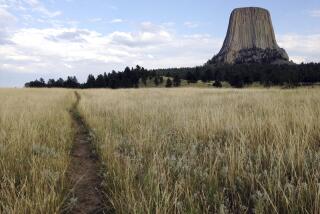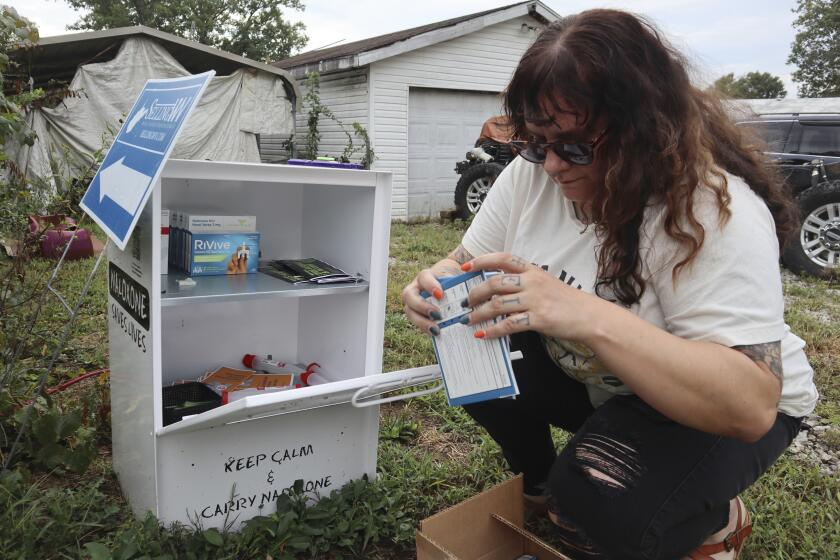A Dying Land Struggles for Redemption
In an eerie silence, heavy with heat and dust, the goats and chickens are dying.
Weak whimpers come from a naked baby girl. To comfort her, Micheline Melidor pats her stomach, cruelly bloated to a semblance of fat by hunger.
There’s nothing to eat here today. Two days ago, the Melidor family finished chewing the last gristle and bones from a scraggly goat that had died of hunger.
It’s the “seshres,” the dryness, says the patriarch of the family, 60-year-old Seleusse Melidor. “No rain. No crops. No trees left to chop down for charcoal.”
He points to the parched earth, bleached gray by lack of moisture. Amid the dried stalks of Palma Christi trees and shriveled peanut plants, the yellow flowers of a weed mock him.
But it’s more than drought. This land is dying.
When Christopher Columbus saw the northwestern corner of Haiti in 1492, he declared the vista of verdant forests and mountains “maravilloso.”
Nearly 500 years later, French ecologist Jacques-Yves Cousteau described the region as “beyond salvation.”
Some areas are a surreal moonscape of denuded mountains ravaged by ravines. Others are exotic with 15-foot-tall cactus and yellow-bark thorn trees, all painted gray by dust.
“In 10 to 15 years it will be a complete desert if we don’t take things in hand now,” said Renaud Voltaire, a hydraulic engineer who is the Ministry of Environment’s officer in charge of northwestern Haiti.
What happened to this area of Haiti, so remote that some villages can be reached only by foot or donkey?
It’s a real-life horror story about how humans can destroy their environment. As if to distance themselves from the nightmare, Creole-speaking Haitians call the area, in English, “The Far West.”
Most Haitians are descendants of African slaves brought here in the late 1600s by French colonizers who destroyed tens of thousands of acres of virgin forest to plant the cane that made Haiti the world’s largest sugar producer. More wood was cut to fuel the sugar mills. Entire forests were shipped to Europe to make furniture of mahogany and dyes from campeachy.
When rebellious slaves defeated Napoleon’s army and Haiti became the world’s first black republic in 1804, great plantations were divided among the slaves turned peasant farmers.
Under an inherited French law, land in Haiti is divided among a man’s heirs. One of the fastest-growing populations in the world--Haitian women average five births each--has reduced the average holding to little more than a half acre. That isn’t enough to support a family of seven even in a good rainy season.
Pressed for income in the Caribbean’s poorest nation, farmers chopped trees to make and sell charcoal. A new World Bank report calculates Haiti lost 40% of its remaining forests in the 1970s and 1980s. Dictator Francois “Papa Doc” Duvalier contributed by clearing forests he feared would provide cover for guerrillas.
From the air, you can see the border with the Dominican Republic, which shares Hispaniola island with Haiti. Lush forests stop suddenly and give way to barrenness. Vast stretches of the Dominican Republic remain in the hands of a wealthy few, and political debates on breaking up the estates to give land to the poor invariably end with Haiti being held up as a warning.
Less than 2% of Haiti’s 10,700 square miles, an area slightly larger than Maryland, is covered by forest today.
Without trees, which “breathe” water vapor into the air, less rain falls on Haiti, and the water table is dropping.
Twenty miles outside the northwestern city of Gonaives, erosion has washed precious topsoil down treeless slopes into the sea, collapsing a highway and carving the hills with new ravines. The turquoise waters turn muddy brown, suffocating the plankton needed by dwindling shoals of fish.
Nemorin Aubriant shakes his fists in anger at similar ravines running down to the sea at Mole St. Nicolas, on the northwestern tip of Haiti, from which a still-green Cuba can be seen.
The fishing was good even five years ago, he said. “I used to get 2,000, 3,000 kilos (up to 6,600 pounds) of fish every day. But now the catch is 250 kilos (550 pounds).”
Fishermen at Mole St. Nicolas used to wade into the surf to fill their nets with fish. Now they have to go farther and farther out to sea because the fish have been driven away by the silt washing down the mountains.
Aubriant, a specialist in Haiti’s fishing industry, said the country imported 8,000 tons of fish in 1978. Today it’s up to 30,000 tons.
Thirty years ago, Haitian farmers produced enough food to feed the country. Today, 34% of foodstuffs are imported.
On a road that doesn’t appear on most maps, near Baie de Henne, Meriantiss Noralien searched out pockets of soil in a field of limestone rocks to plant peanuts. He worried about whether it would rain and how he would feed his wife and four children until the harvest, three months away.
“We worked for people cutting trees to make charcoal and buy some food. But it’s only God that has helped us, that we are not dead yet,” he said.
It used to be a religious taboo in Haiti to cut down a cottonwood tree. That’s where a father would bury the umbilical cord of a new family member, believing it held the baby’s soul.
Now it isn’t only cottonwoods that fall.
“I’ve seen farmers cutting down mango trees and papaya trees to make charcoal,” said Voltaire, the environmental official.
Haitian farmers are being forced “either to cut down the few remaining forests” and increase erosion, “or join the exodus to the cities and abroad,” the World Bank said in a recent report.
This year’s drought has produced more environmental refugees.
Melidor said only his brother still farms in the immediate area. “People left and went to Port-de-Paix, to Port-au-Prince, to Gonaives, even to Miami,” he said.
Some believe that is the only answer. Both Haitian and foreign development workers suggest a mass relocation of people to urban centers where factories could be set up, or to land in the south still capable of sustaining life. Without such measures, they say, the daily fight against hunger will turn into famine within a generation.
CARE, the U.S. humanitarian group, is pursuing agricultural projects that are considered feasible only because Haiti’s environment is so degraded.
Around the comparatively green oasis of Bombardopolis, where CARE has its northwest office, CARE consultant Marshall D. Ashley is helping build walls into ravines to catch topsoil washed down by rain.
Since February 1996, peasants who are paid the minimum wage or with wheat and dried beans have built 666 stone walls by hand. The walls range from 15 to 50 feet high.
The first project of 337 walls, financed by the Haitian government, collected about 5 acres of rich red soil for planting.
“It doesn’t sound like much. And if you were in the United States, say, this project would not be economically feasible,” said Ashley. “But the farmers who got to plant that land made $10,000 last year.”
When the Haitian government ran out of money for the project, the U.S. Agency for International Development came up with the funds.
Because corruption and political infighting have preoccupied successive Haitian governments, CARE has grown into the most important provider of health care, emergency food, trees and irrigation systems.
“We’ve planted 10 million trees here over the last 10 years. What if those trees hadn’t been there to be used [for charcoal]?” asked Thomas Friedeberger, the CARE director in Haiti. “It would be much worse.”
He is enthusiastic about a new project to rehabilitate four small silt-filled and eroded irrigation canal systems. “There are identifiable sources of water left,” he said.
But for how long?
A half-mile-wide riverbed that used to overflow its banks in the rainy season is now the main road leading east out of Jean-Rabel.
Anna Bissainthe recalled how, 65 years ago, she dived into a northern river that frightened her, “it was so deep and cold.” When she returned recently, she stepped across a small stream.
People told her that was the river.
More to Read
Sign up for Essential California
The most important California stories and recommendations in your inbox every morning.
You may occasionally receive promotional content from the Los Angeles Times.










